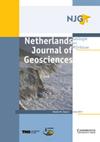Facies characterisation of sediments from the East Frisian Wadden Sea (Germany): new insights from down-core scanning techniques
IF 2.3
2区 地球科学
Q3 GEOSCIENCES, MULTIDISCIPLINARY
Netherlands Journal of Geosciences-Geologie En Mijnbouw
Pub Date : 2021-04-05
DOI:10.1017/njg.2021.6
引用次数: 4
Abstract
Abstract Sediment facies provide fundamental information to interpret palaeoenvironments, climatic variation, archaeological aspects and natural resource potentials since they are summary products of depositional processes, environmental conditions and biological activities for a given time and location. The conventional method of facies discrimination relies on macroscopic and/or microscopic determination of sediment structures combined with basic physical, chemical and biological information. It is a qualitative measure, depending on observer-dependent sedimentological descriptions, which cannot be reanalysed readily by further studies. Quantitative laboratory measurements can overcome this disadvantage, but are in need of large sample numbers and/or high temporal resolution, and are time-, labour- and cost-intensive. In order to facilitate an observer-independent and efficient method of facies classification, our study evaluates the potential of combining four non-destructive down-core scanning techniques: magnetic susceptibility (MS), X-ray computed tomography (CT), X-ray fluorescence (XRF) and digital photography. These techniques were applied on selected sections of sediment cores recovered around the island of Norderney (East Frisian Wadden Sea, Germany). We process and integrate the acquired scanning measurements of XRF elemental intensities, represented by principal components, MS, CT density and lightness of eight sediment facies previously recognised by conventional facies analysis: moraine, eolian/fluvial, soil, peat, lagoonal, sand flat, channel fill and beach-foreshore. A novel type of density plot is introduced to visualise the digitised sediment information that allows an observer-independent differentiation of these facies types. Thus, the presented methodology provides the first step towards automated supervised facies classification with the potential to reproduce human assessments in a fully reproducible and quantitative manner.东弗里斯兰瓦登海(德国)沉积物的相特征:来自岩心扫描技术的新见解
沉积相是特定时间和地点沉积过程、环境条件和生物活动的综合产物,为解释古环境、气候变化、考古方面和自然资源潜力提供了基础信息。传统的相判别方法依赖于对沉积物结构的宏观和/或微观测定,并结合基本的物理、化学和生物信息。这是一种定性的测量,取决于依赖于观察者的沉积学描述,不能通过进一步的研究轻易地重新分析。定量实验室测量可以克服这一缺点,但需要大量样本和/或高时间分辨率,并且时间、劳动力和成本密集。为了促进一种独立于观察者的高效相分类方法,我们的研究评估了结合四种非破坏性下岩心扫描技术的潜力:磁化率(MS)、x射线计算机断层扫描(CT)、x射线荧光(XRF)和数字摄影。这些技术被应用于在Norderney岛(德国东弗里斯兰瓦登海)周围回收的沉积物岩心的选定部分。我们处理并整合了获得的XRF元素强度的扫描测量结果,这些元素强度由主成分、质谱、CT密度和亮度表示,这些元素是由传统相分析所识别的8种沉积相:冰碛、风成/河流、土壤、泥炭、泻湖、沙滩、河道填充物和海滩前滩。引入了一种新型的密度图,将数字化的沉积物信息可视化,从而可以独立于观察者对这些相类型进行区分。因此,所提出的方法为实现自动监督相分类提供了第一步,具有以完全可重复和定量的方式再现人类评估的潜力。
本文章由计算机程序翻译,如有差异,请以英文原文为准。
求助全文
约1分钟内获得全文
求助全文
来源期刊
CiteScore
4.00
自引率
25.90%
发文量
14
审稿时长
>12 weeks
期刊介绍:
Netherlands Journal of Geosciences - Geologie en Mijnbouw is a fully open access journal which publishes papers on all aspects of geoscience, providing they are of international interest and quality. As the official publication of the ''Netherlands Journal of Geosciences'' Foundation the journal publishes new and significant research in geosciences with a regional focus on the Netherlands, the North Sea region and relevant adjacent areas. A wide range of topics within the geosciences are covered in the journal, including "geology, physical geography, geophyics, (geo-)archeology, paleontology, hydro(geo)logy, hydrocarbon exploration, modelling and visualisation."
The journal is a continuation of Geologie and Mijnbouw (published by the Royal Geological and Mining Society of the Netherlands, KNGMG) and Mededelingen Nederlands Instituut voor Toegepaste Geowetenschappen (published by TNO Geological Survey of the Netherlands). The journal is published in full colour.

 求助内容:
求助内容: 应助结果提醒方式:
应助结果提醒方式:


